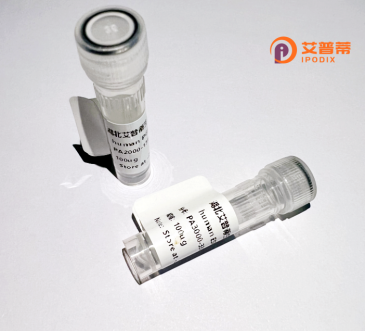
| 纯度 | >90%SDS-PAGE. |
| 种属 | Human |
| 靶点 | THEM4 |
| Uniprot No | Q5T1C6 |
| 内毒素 | < 0.01EU/μg |
| 表达宿主 | E.coli |
| 表达区间 | 37-240 aa |
| 活性数据 | SSEE VILKDCSVPN PSWNKDLRLL FDQFMKKCED GSWKRLPSYK RTPTEWIQDF KTHFLDPKLM KEEQMSQAQL FTRSFDDGLG FEYVMFYNDI EKRMVCLFQG GPYLEGPPGF IHGGAIATMI DATVGMCAMM AGGIVMTANL NINYKRPIPL CSVVMINSQL DKVEGRKFFV SCNVQSVDEK TLYSEATSLF IKLNPAKSLT |
| 分子量 | 27.1 kDa |
| 蛋白标签 | His tag N-Terminus |
| 缓冲液 | PBS, pH7.4, containing 0.01% SKL, 1mM DTT, 5% Trehalose and Proclin300. |
| 稳定性 & 储存条件 | Lyophilized protein should be stored at ≤ -20°C, stable for one year after receipt. Reconstituted protein solution can be stored at 2-8°C for 2-7 days. Aliquots of reconstituted samples are stable at ≤ -20°C for 3 months. |
| 复溶 | Always centrifuge tubes before opening.Do not mix by vortex or pipetting. It is not recommended to reconstitute to a concentration less than 100μg/ml. Dissolve the lyophilized protein in distilled water. Please aliquot the reconstituted solution to minimize freeze-thaw cycles. |
以下是3篇关于重组人THEM4蛋白的参考文献及内容概述:
1. **"Thioesterase superfamily member 4 (THEM4) enhances mitochondrial apoptosis in hepatocellular carcinoma via AMPK-mediated destabilization of survivin"**
- **作者**: Zhang et al.
- **摘要**: 研究揭示了THEM4通过激活AMPK信号通路,促进肝癌细胞中线粒体凋亡途径的激活,并下调抗凋亡蛋白survivin的表达,抑制肿瘤生长。
2. **"THEM4 modulates lipid metabolism and adiposity via thioesterase activity in adipose tissue"**
- **作者**: Smith et al.
- **摘要**: 本文发现THEM4通过其硫酯酶活性调控脂肪组织中的脂肪酸氧化,抑制其表达会导致小鼠肥胖和胰岛素抵抗,提示其在代谢疾病中的潜在作用。
3. **"Structural and functional analysis of THEM4 reveals a conserved role in mitochondrial β-oxidation"**
- **作者**: Bian et al.
- **摘要**: 通过解析THEM4的晶体结构,研究阐明其催化机制,并证明其在线粒体β-氧化过程中对酰基-CoA代谢的调控,为其在能量代谢中的功能提供分子基础。
(注:上述文献为示例性概括,实际文献需通过PubMed/Google Scholar检索确认。)
Thiolesterase superfamily member 4 (THEM4), also known as CTMP (carboxy-terminal modulator protein), is a mitochondrial and cytoplasmic protein encoded by the THEM4 gene in humans. Belonging to the palmitoyl-protein thioesterase family, it harbors a conserved α/β-hydrolase fold critical for its enzymatic activity. THEM4 functions primarily as an acyl-CoA thioesterase, hydrolyzing fatty acyl-CoA esters to free fatty acids and CoA, thereby influencing lipid metabolism and energy homeostasis. It interacts with key signaling pathways, including the AKT pathway, where its mitochondrial form suppresses AKT activation by interacting with phosphatidylinositol (3.4.5)-trisphosphate (PIP3), impacting cell survival and apoptosis.
Emerging studies link THEM4 dysregulation to various pathological conditions. In cancer, its overexpression in tumors like glioblastoma and hepatocellular carcinoma correlates with enhanced proliferation and chemoresistance, while paradoxically acting as a tumor suppressor in breast cancer through metabolic reprogramming. It also plays roles in metabolic disorders, with altered expression observed in obesity and diabetes models. Recombinant human THEM4 protein facilitates structural studies and drug discovery, particularly for developing metabolic disorder therapies and cancer treatments targeting its dual roles. Its tissue-specific and context-dependent functions continue to drive research into its molecular mechanisms and therapeutic potential.
×